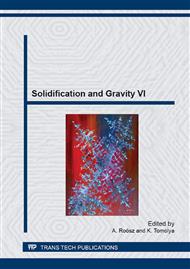p.402
p.408
p.414
p.420
p.429
p.435
p.441
p.447
p.452
On Factors Influencing Macro Shrinkage Porosity Formation in Compacted Graphite Iron
Abstract:
The purpose of this work is to investigate the relation between macro shrinkage porosity level and the level of graphite nodularity, gaseous elements and the size of eutectic colonies in compacted graphite iron. Also, the internal shrinkage-pore surfaces were analyzed by SEM and EDS techniques. It was found that samples with higher shrinkage porosity level, contained higher level of graphite nodularity and number of eutectic colonies. Also, samples with higher level of gaseous elements (Hydrogen and Nitrogen) showed higher tendency to shrinkage porosity formation. Austenite dendrites with different morphologies were observed inside the pores, indicating that were formed at different times during solidification, and the surface of the pores were covered with a layer of carbon film indicating that the pores were internal, with no contact to the atmosphere at elevated temperatures.
Info:
Periodical:
Pages:
429-434
Citation:
Online since:
May 2014
Authors:
Price:
Сopyright:
© 2014 Trans Tech Publications Ltd. All Rights Reserved
Share:
Citation:


